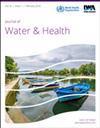神户市公共洗浴设施军团菌流行及遗传分布
IF 2.5
4区 环境科学与生态学
Q3 ENVIRONMENTAL SCIENCES
引用次数: 0
摘要
摘要军团菌是引起军团病的重要水源病原菌。在日本,公共浴室被认为是军团菌病感染的主要原因。2016 - 2021年,通过年度定期监测,对日本神户市81个公共洗浴设施(包括35个温泉和46个其他设施)338株军团菌的流行情况和遗传分布进行了调查。此外,还将同一时期9株未知传染源的临床菌株与洗澡水分离株的基因型进行了比较。我们分析了温泉与其他公共浴场之间军团菌种类、血清群和基因型分布的差异。以色列军团菌、londiniensis和micdadei与嗜肺乳杆菌一起在温泉中定居。基于多位点可变数串联重复序列分析(MLVA)的最小生成树分析还鉴定出嗜肺乳杆菌SG1的4个主要克隆复合物(cc),发现这4个cc的CC1是一个具有lag-1基因的特殊新基因型,存在于温泉中。从洗澡水中分离的菌株没有与临床菌株相同的MLVA和序列类型。因此,我们的监测对估计日本军团菌感染的来源和制定预防策略是有用的。本文章由计算机程序翻译,如有差异,请以英文原文为准。
Prevalence and genetic distribution of Legionella spp. in public bath facilities in Kobe City, Japan
Abstract Legionella is an important waterborne pathogen that causes legionellosis. Public baths are considered the primary cause of legionellosis infection in Japan. We investigated the prevalence and genetic distribution of 338 Legionella spp. isolates from 81 public bathing facilities, including 35 hot springs and 46 other facilities, through annual periodic surveillance in Kobe, Japan, from 2016 to 2021. In addition, the genotypes of nine clinical strains of unknown infectious source from the same period were compared to those of bathwater isolates. We elucidated the differences in the distribution of Legionella species, serogroups, and genotypes between hot springs and other public baths. Legionella israelensis, L. londiniensis, and L. micdadei colonized hot springs along with L. pneumophila. The minimum spanning tree analysis based on multiple-locus variable number tandem repeat analysis (MLVA) also identified four major clonal complexes (CCs) in L. pneumophila SG1 and found that CC1 of the four CCs is a specific novel genotype with the lag-1 gene that occurs in hot springs. The same MLVA and sequence types as those of the clinical strains were not present among the strains isolated from bath water. Thus, our surveillance is useful for estimating the sources of legionellosis infection in Japan and developing prevention strategies.
求助全文
通过发布文献求助,成功后即可免费获取论文全文。
去求助
来源期刊

Journal of water and health
环境科学-环境科学
CiteScore
3.60
自引率
8.70%
发文量
110
审稿时长
18-36 weeks
期刊介绍:
Journal of Water and Health is a peer-reviewed journal devoted to the dissemination of information on the health implications and control of waterborne microorganisms and chemical substances in the broadest sense for developing and developed countries worldwide. This is to include microbial toxins, chemical quality and the aesthetic qualities of water.
 求助内容:
求助内容: 应助结果提醒方式:
应助结果提醒方式:


